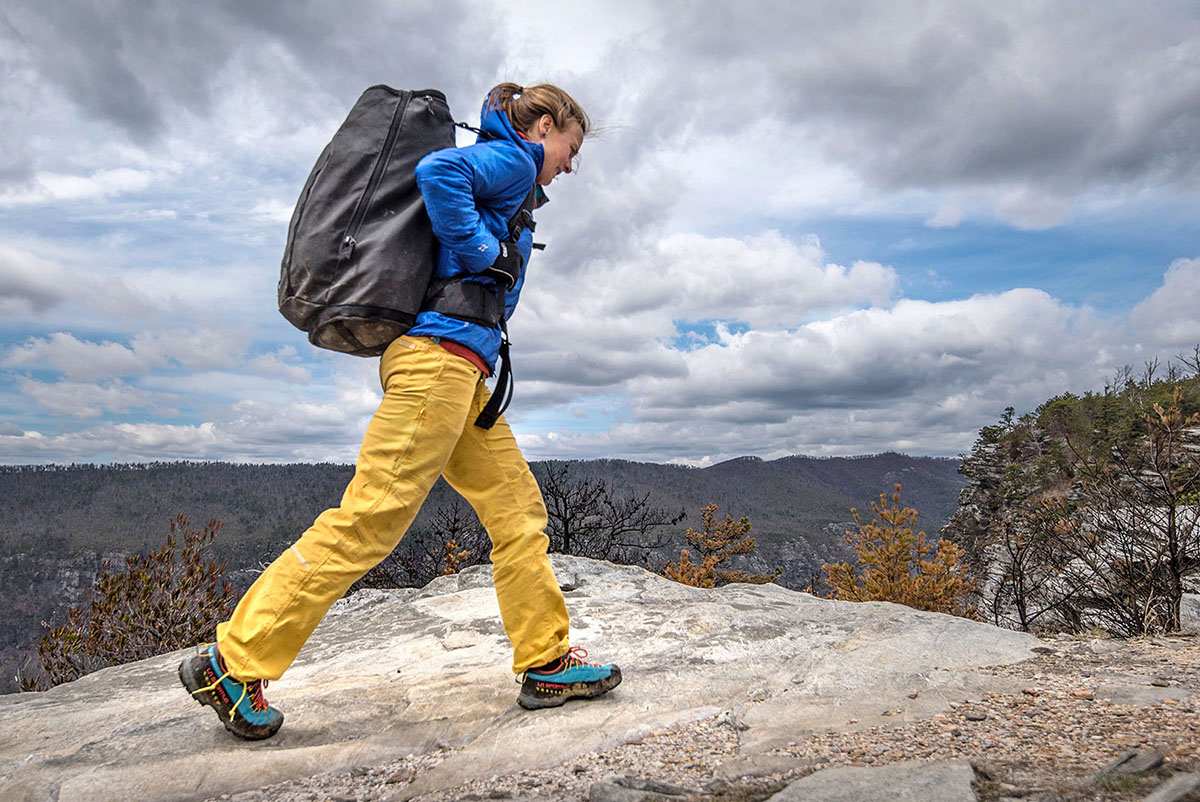
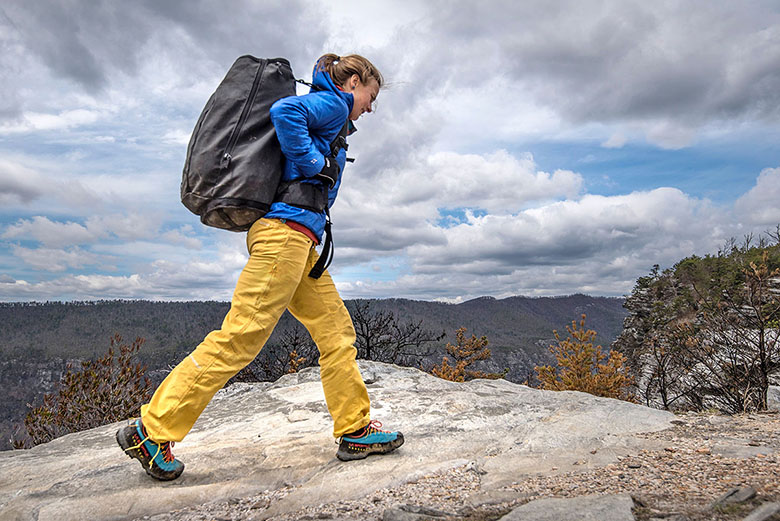
Combining the features of hiking shoes, climbing slippers, and even mountaineering boots, approach shoes are in a category of their own. For climbers, they’re an essential piece of footwear that provides stability and traction on rock in addition to comfort for miles on the trail. And because approaches can take on so many different forms—from walking to the crag to scrambling fourth or fifth class or embarking on a multi-day slog—approach shoes are a diverse bunch. Below we break down the top approach shoes of 2025, including comfortable crag and trail shoes, nimble climbers, and mid-height waterproof models. For more background information, see our comparison table and buying advice below the picks, along with details about our testing process.
Editor’s note: We updated this guide on February 6, 2025, to add the Scarpa Mescalito Planet, Scarpa Rapid, and Black Diamond Session Suede to our list. We also removed several discontinued shoes from Scarpa, Black Diamond, Arc'teryx, and La Sportiva. Finally, we incorporated fresh photos from recent testing and expanded a few sections in our buying advice.
 Category: All-around/scrambling
Category: All-around/scrambling
Weight: 1 lb. 12.0 oz.
Upper: Leather
What we like: Hardwearing leather upper and well-rounded performance; we appreciate La Sportiva’s recent sustainability upgrades.
What we don’t: Narrower and stiffer out of the box than the prior version; breathability is limited in hot summer conditions.
La Sportiva’s popular TX series combines features from climbing shoes, mountaineering boots, and mountain running shoes, ranging from the superlight TX2 Evo below to the burly TX Hike Mid GTX hiking boots. Of this venerable grouping, we like the balanced TX4 Evo best. It offers a standout combination of protection, comfort, and durability and is suitable for everything from toting up a climb on your harness to long hikes with heavy loads. Another highlight is the Vibram Megagrip outsole, which is noticeably high-quality and among the stickiest we’ve tested for both scrambling and hiking. Finally, the latest Evo model has a nice sustainability slant with recycled materials throughout and a platform that can be resoled to maximize the shoes’ lifespan.
That said, we do have some complaints about the recent changes that La Sportiva made. Although the latest TX4 Evo incorporates eco-friendlier touches, it’s a couple ounces heavier than the original model and noticeably stiffer out of the box. To be fair, our pair is breaking in nicely, but several users have confirmed our initial impressions: They lack the soft, foot-hugging feel of the prior version. They’re narrower, too, which may be a dealbreaker for those with particularly high-volume feet (the original model’s wide toe box was a boon for on-trail comfort). But overall, the core DNA of our favorite all-around approach shoe remains—including standout grip, well-rounded performance, and a hardwearing build that will stand the test of time.
Read more: women's La Sportiva TX4 Evo Mid GTX review (boot version)
See the Men's La Sportiva TX4 Evo See the Women's La Sportiva TX4 Evo

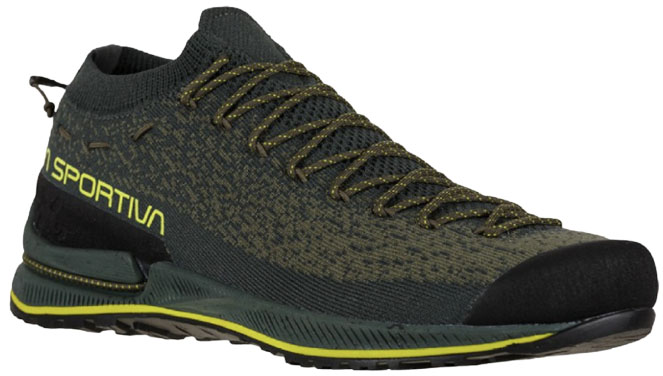 Category: Cragging/all-around
Category: Cragging/all-around
Weight: 1 lb. 4.4 oz.
Upper: Knit
What we like: A great shoe for toting up walk-off routes.
What we don’t: Minimal support and durability.
The TX2 Evo is not only the lightest member of the La Sportiva TX family—it’s the lightest model on our list (among those that provide a weight spec). At just 10.2 ounces per shoe, the minimalist design packs in a surprising number of thoughtful features. The flat sole, rigid toe box, and sticky Vibram Idrogrip rubber lend themselves to excellent performance on technical rock, and you get a snug fit by way of the pliable knit upper and customizable lacing system. Breathability is excellent for hot summer days, and the TX2 will also drain and dry quickly following a river crossing. And with an elastic loop that connects the shoes for streamlined carry on your climbing harness, it’s our hands-down favorite for hauling up routes with walk-off descents.
Our biggest knock against the TX2 Evo is that it isn’t particularly durable, especially when pushed to its limits. It’s true that La Sportiva designed the latest Evo version to be easily resoled, but based on our experiences with the first-gen TX2, the upper will likely be the first component to fail—and several user reviews confirm that the latest version is even more susceptible to premature wear. Further, with a flat sole and little in the way of support or cushion, the shoe falls short for long days on the trail. But for short approaches to the crag, easy scrambles, and toting up climbs, it’s hard to beat the feathery weight and easy portability. For a more durable option, La Sportiva also makes the TX2 Evo Leather, which is cheaper ($149) and only slightly heavier at 1 pound 4.8 ounces per pair.
See the Men's La Sportiva TX2 Evo See the Women's La Sportiva TX2 Evo
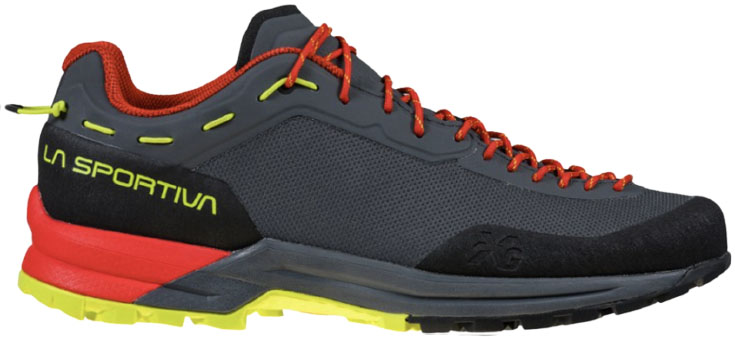 Category: Scrambling/all-around
Category: Scrambling/all-around
Weight: 1 lb. 8.6 oz.
Upper: Mesh
What we like: A high-performance shoe for technical climbing and mountain scrambling.
What we don’t: Expensive and less durable than the TX4 Evo; decidedly narrow fit.
If you’ve been around climbing for long enough, chances are you remember the La Sportiva Ganda. A favorite among experienced climbers and guides, the streamlined Ganda was the shoe to wear while climbing fifth-class rock. After a multi-year hiatus, La Sportiva introduced the TX Guide as their high-tech offering, and we like it a lot. Compared to the TX4 Evo above, the Guide is lighter, leaner, more sensitive, and stickier—in other words, it’s a better option for technical climbing and scrambling. It’s also nicely padded underfoot (touted as having the cushioning of a mountain runner), which is great for comfort and speed on the trail.
It’s important to note that the TX Guide is built on a different last than other models in the TX lineup, which is considerably narrower in the toe box. Further, you do give up some durability with the mesh upper (La Sportiva also makes a slightly heavier and more robust leather version), and the Guide’s sticky sole won’t hold up quite as well as stiffer rubber compounds. But these trade-offs make it wildly impressive on technical rock: We forgot to pack our climbing shoes for a six-pitch 5.10+ in Washington's alpine, and the Guide proved to be a surprisingly capable substitute. Not everyone needs such a high-performance shoe (or will want to pay for it), but if you’re inclined toward long days of mountain scrambling with some technical climbing and fast hiking mixed in, the TX Guide is our top choice.
See the Men's La Sportiva TX Guide See the Women's La Sportiva TX Guide
 Category: Mountain
Category: Mountain
Weight: 2 lb. 0.3 oz.
Upper: Suede
What we like: A powerful and durable shoe for mountain environments.
What we don’t: Narrow fit isn’t great for everyone; too heavy and clunky for technical climbing.
Straight out of Montebelluna, Italy—otherwise known as the boot-making capital of the world—Salewa’s Mountain Trainer 2 GTX is an approach shoe truly designed for the mountains. With the wraparound protection of a full rubber rand, a waterproof Gore-Tex membrane, and a durable Vibram sole, the Mountain Trainer is more akin to a tank than a race car, making it well suited for off-trail travel that involves navigating talus slopes, kicking steps in snow, boulder-hopping, and more. Even for non-climbers interested in exploring the alpine with a lighter and more form-fitting shoe, the Salewa Mountain Trainer 2 is an excellent choice.
Scarpa's Mescalito Planet below is another one of our favorite approach shoes for the mountains, but the two designs have some notable differences. First and foremost, the Salewa is significantly heavier at just over 2 pounds for the pair (compared to 1 lb. 5.4 oz. for the Scarpa), although the extra heft does get you a waterproof membrane and a substantial boost in protection. The Scarpa is overall a better scrambling shoe with rounded tread and a firm edging platform, while the Salewa has sharper lugs that make it a better choice for wet and soft terrain like mud and snow. Keep in mind that the latest Mountain Trainer 2 is very narrow, and an integrated stretch gaiter at the tongue makes it difficult to slip on. But for the right environments, or as a lightweight substitute for a mountaineering boot, it’s hard to beat the durability and protection the Salewa provides. Note: The women's model is largely out of stock at the time of publishing, but the men's version is going strong.
See the Men's Salewa Mountain Trainer 2 GTX

 Category: All-around
Category: All-around
Weight: 1 lb. 4.8 oz.
Upper: Mesh
What we like: The comfort of a trail runner with the grip of an approach shoe.
What we don’t: Flexible build and lack of edging capabilities make it difficult to pull precise climbing moves.
We’ve included a lot of La Sportiva shoes in our top picks but would be remiss to overlook the other Italian footwear giant: Scarpa. The Rapid is the brand's shoe for the well-rounded mountain athlete, occupying a unique space at the junction between trail runner and approach shoe. The sole of the Rapid is constructed with the same sticky rubber found on Scarpa's high-performance approach shoes, while the rest of the build maintains the comfort and support of their trail lineup. In testing, we found that the reinforced mesh upper holds up well over the long term, and the dual-density EVA midsole makes it easy to cover significant mileage, keeping your feet and calves fresh for the send. For those massive backcountry missions with a 10-mile approach over non-technical terrain, this is the tool for the job.
However, for approaches that involve technical scrambling or low-fifth-class climbing, we would direct you elsewhere. The biggest sacrifice is the lack of edging capabilities: The Rapid's toe is much more flexible than what you'll find on most dedicated approach shoes, making precise placements or smears on slab tricky. Additionally, while the Vibram Agility/Megagrip outsole bites well into rocky terrain, we found ourselves wishing for more purchase and rigidity when things got vertical. But again, for long slogs or ridgeline scrambles that don't require ultra-precise footwork, the Rapid is a very versatile tool.
See the Men's Scarpa Rapid See the Women's Scarpa Rapid
 Category: Cragging/all-around
Category: Cragging/all-around
Upper: Suede
What we like: A casual and comfortable approach shoe with a unique bootie-like fit.
What we don’t: Outsole rubber is not super sticky.
Approach shoes have become so ubiquitous amongst climbers that it’s common to see them not just at the crag but at the brewery, the gym, and everywhere in between. But models like the TX4 Evo and Mountain Trainer above can be fairly overbuilt (read: uncomfortable) for daily use. Black Diamond’s Session Suede, on the other hand, is built with casual intentions, combining urban styling and a soft, bootie-like upper with all the features we look for in an approach shoe. The result is a comfortable and easy-wearing shoe that both looks good and plays hard.
One of our favorite features of the Session is its heel, which includes an elastic stretch that makes the shoe easy to pull on and off without bothering with the laces. The heel also folds down for use as a slip-on, which is a great feature for gym climbing, bouldering, or just hanging around the house. Keep in mind that Black Diamond’s BlackLabel-Street rubber is designed for use on pavement, so the Session is built to last but offers less grip on rock than more performance-oriented shoes. It also isn't nearly as stiff or supportive as many alternatives here, limiting its appeal for demanding missions like big-wall ascents. But for cragging, easy approaches, and wearing casually, the Session Suede has a lot of appeal.
See the Men's BD Session Suede See the Women's BD Session Suede
 Category: All-around
Category: All-around
Weight: 1 lb. 12.8 oz.
Upper: Suede
What we like: A comfortable and relatively inexpensive all-rounder.
What we don’t: Not our favorite outsole design; less capable for climbing than the TX4 Evo above.
The Crux is Scarpa’s classic all-around approach shoe, built to handle miles of hiking and the occasional off-trail scramble. With a suede upper and Kevlar webbing that connects the laces to the midfoot, you get the snug fit of a leather shoe but without too much stretch—in our experience, the Crux has a lot more structure than the similarly intentioned La Sportiva Boulder X below. And while a generous dose of cushioning underfoot means the Crux isn’t the strongest edger, it’s a very comfortable hiking shoe and has performed well for us on everything from heinous sidehill slogs to classic moderates like Wolf’s Head in Wyoming's Wind River Range.
In terms of outsole design, we give the edge to the La Sportiva TX4 Evo above, which has more aggressive, diamond-shaped lugs that offer superior grip on rock. The TX4 also offers better edging capabilities thanks to the stiffer platform underfoot. On the flip side, the Crux's relatively flexible and cushioned sole is by far the more comfortable pick for miles of easy hiking on the trail (although it's no featherweight at 1 lb. 12.8 oz. per pair). Taken together, for casual approaches where you don’t need to carry your shoes on your harness, the Crux is a foot-friendly and well-rounded choice.
Read more: women's Scarpa Crux review (prior version)
See the Men's Scarpa Crux See the Women's Scarpa Crux
 Category: All-around
Category: All-around
Weight: 2 lb. 1.9 oz.
Upper: Leather
What we like: Sticky rubber and quality leather upper for $20 less than the TX4 Evo.
What we don’t: Heavy and bulky.
For climbers who are just starting out or traditionalists looking for a value option, La Sportiva’s Boulder X fits the bill nicely. For $20 less than the top-ranked TX4 Evo, the Boulder X is extremely comfortable with a quality leather upper, excels on the trail, climbs third- and fourth-class terrain well, and boasts insanely sticky rubber. While entirely subjective, we also like the look of the shoe—while far from the most modern choice here, it has a classic, timeless appearance that’s not out of place on the trail or around town.
What are the downsides of the Boulder X? The shoe is too heavy to carry on a harness, doesn’t edge well on fifth-class terrain, and boasts a bulky sole that doesn't take aluminum crampons well. Moreover, the leather upper stretches so much when wet that we’ve had issues with our feet twisting in the toe box, resulting in a tear where the rubber rand meets leather. That said, if you have wide feet and want an entry-level shoe that is a beast on the trail, the Boulder X should be near the top of your list.
See the Men's La Sportiva Boulder X See the Women's La Sportiva Boulder X
 Category: Mountain/all-around
Category: Mountain/all-around
Weight: 1 lb. 9.8 oz.
Upper: Synthetic
What we like: A highly durable and protective shoe for demanding mountain travel.
What we don’t: Expensive; rounded lugs aren’t super aggressive on soft terrain.
Scarpa's popular Mescalito Planet is purpose-built to tackle demanding mountain objectives in a lightweight package. It has emerged as a climber favorite for wider feet, impressing us with its hiking comfort, durability, and support. Underfoot, the Vibram Megagrip sole features rounded, rectangular lugs that are versatile for both rock and soft terrain, along with a climbing zone at the front for precision while edging and smearing on rock. Finally, the upper is made from 45%-recycled yarns, while the midsole uses 45%-recycled foam, making this a great choice for the eco-conscious climber.
The Mescalito Planet is a go-to choice for mountain guides and serious climbers who get out a lot, but it’s not our recommendation for most climbers. First, at $219, it’s one of the more expensive shoes here, and you don’t get the Gore-Tex waterproofing of models like the Salewa Mountain Trainer above or Zamberlan Salathe GTX RR below. Further, the Mescalito Planet can feel heavier and clunkier on casual, on-trail approaches, and the jack-of-all-trades tread isn’t particularly aggressive on loose terrain like mud, snow, and scree. But for serious forays into the mountains, it offers a competitive mix of durability, weight, and grip. Note: The Mescalito Planet is discounted at the time of publishing, but there's still good stock available, so we've opted to keep it featured here while supplies last.
See the Men's Scarpa Mescalito Planet See the Women's Scarpa Mescalito Planet
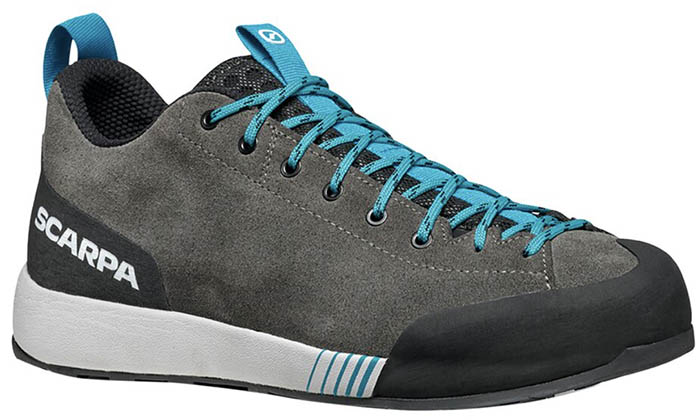 Category: Scrambling/all-around
Category: Scrambling/all-around
Weight: 1 lb. 6.6 oz.
Upper: Suede
What we like: A technically minded approach shoe that’s offered in both suede and synthetic versions.
What we don’t: Stiff build isn’t ideal for long approaches.
Scarpa’s goal with the Gecko was to make a slimmed-down but precise approach shoe that excels on technical terrain. Overall, we think they did a pretty good job: The slip-lasted toe box is designed with climbing in mind and boasts a sensitive feel, over-the-toe rubber for jamming in cracks, and an aggressive outsole for smearing and technical edging. To balance things out, the heel is board-lasted (read: stiffer) for stability, and a cushioned EVA midsole adds comfort for the trail (as long as your load isn’t too heavy or your approach too long). If the La Sportiva TX Guide above caught your eye, the Gecko is well worth a closer look, too.
The standard Gecko features a suede upper, which offers a long lifespan, custom fit (leather stretches to the shape of your foot over time), and modest water resistance—especially when treated with a leather conditioner. It’s worth noting that Scarpa also offers the Gecko LT ($169), which mimics the original design but swaps out the suede upper for a lighter-but-still-durable ripstop synthetic fabric. The result is a slightly lower-profile feel, which translates to better precision on technical terrain. Synthetic uppers have become increasingly durable (the TX Guide is a prime example), and they’re often the best option for climbers looking for high performance. Regardless of which model you choose, both Geckos are stellar approach shoes intended for those who spend a lot of time on technical terrain.
See the Men's Scarpa Gecko See the Women's Scarpa Gecko
 Category: Mountain/all-around
Category: Mountain/all-around
Weight: 1 lb. 15.4 oz.
Upper: Suede
What we like: Bombproof durability and excellent support for long mountain missions.
What we don’t: Heavy, clunky, and expensive; upturned toe detracts from precision.
Joining Salewa’s Mountain Trainer 2 GTX above is another mountain-ready design to have on your radar: Zamberlan’s Salathe GTX RR. Compared to the Salewa and most other designs on our list, the Salathe has a slightly taller cut (by around 0.5 in.) that provides a nice dose of added ankle support—great for long and technical approaches that involve a mix of trail and scrambling. Attention to detail is also impressive, including a tough suede upper and full rubber rand for protection against harsh impacts. Finally, while we generally prefer non-waterproof approach shoes for their breathability, the Salathe’s Gore-Tex Extended Comfort lining does a decent job regulating heat—and we’ve certainly appreciated it on puddle-strewn approaches (they're great on snowy patches of trail, too).
In our experience, fit is another one of the Zamlerlan’s selling points: We’ve had no trouble effectively customizing tightness whether cinching things down on technical scrambling and light climbing missions or loosening the laces on long treks back to the car. We’ve also found there to be adequate room in the toe box to account for natural foot swelling as the miles add up, although some users report a narrow fit at the front. In our experience, the bigger issue is the upturn of the forefoot, which results in less precision when toeing in on small edges or smearing across slick slab. Coupled with the Salathe’s 1-pound-15.4-ounce weight, these shoes have a relatively clunky and imprecise feel compared to many of the picks above. And then there’s the $280 price tag, which will be out of reach for many. But for mountain athletes who prioritize long-term durability and support, we’ve been really impressed by the Salathe’s performance. It's also sold in a true mid-height boot version for $50 more.
See the Men's Zamberlan Salathe GTX RR
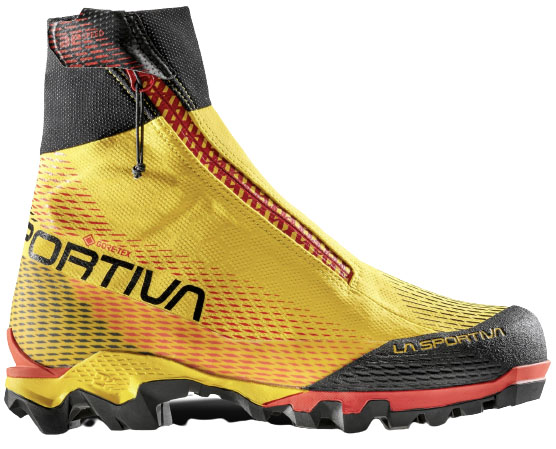 Category: Mountain
Category: Mountain
Weight: 2 lb. 5.4 oz.
Upper: Synthetic
What we like: Great for snowy approaches; heel bail takes semi-automatic crampons.
What we don’t: Heavy and lacks the precision of traditional approach shoes.
Climbers love to push the limits of approach shoes, but some terrain—think the North Cascades, early-season Tetons, or Patagonia—quite simply demands more from your footwear. It’s no easy feat finding a boot that’s capable (and comfortable) on easy trail, glacier, and rock, but La Sportiva’s Aequilibrium Speed GTX checks the boxes better than most. Like an approach shoe, it’s flexible and cushioned enough to retain good comfort mile after mile, and the lightweight build won’t weigh your pack down too much on the climb. On the other hand, with a mid-height cut and heel bail, the Aequilibrium Speed offers the best stability and crampon compatibility of any approach shoe here.
The Aequilibrium Speed’s tall collar and significant bump in weight mean it’s too heavy and bulky for most summer objectives, especially when you’re carrying your gear up and over a climb. Additionally, with the Gore-Tex lining, you’ll compromise on breathability compared to a non-waterproof shoe like the TX4 Evo above. And finally, with such lightweight construction, the Speed suffers in terms of durability when held up against comparable mountaineering boots. But for mixed conditions or long snowy approaches to alpine rock, the Aequilibrium Speed could be Sportiva’s best solution yet.
See the Men's La Sportiva Aequilibrium Speed See the Women's La Sportiva Aequilibrium Speed
| Shoe | Price | Category | Weight | Upper | Sole |
|---|---|---|---|---|---|
| La Sportiva TX4 Evo | $169 | All-around/scrambling | 1 lb. 12.0 oz. | Leather | Vibram Megagrip |
| La Sportiva TX2 Evo | $159 | Cragging/all-around | 1 lb. 4.4 oz. | Knit | Vibram Idrogrip |
| La Sportiva TX Guide | $179 | Scrambling/all-around | 1 lb. 8.6 oz. | Mesh | Vibram Megagrip/Idrogrip |
| Salewa Mtn Trainer 2 GTX | $230 | Mountain | 2 lb. 0.3 oz. | Suede | Vibram Mtn Trainer Evo |
| Scarpa Rapid | $169 | All-around | 1 lb. 4.8 oz. | Mesh | Vibram Agility/Megagrip |
| Black Diamond Session Suede | $150 | Cragging/all-around | Unavailable | Suede | BlackLabel-Street |
| Scarpa Crux | $149 | All-around | 1 lb. 12.8 oz. | Suede | Vibram Approach/Megagrip |
| La Sportiva Boulder X | $149 | All-around | 2 lb. 1.9 oz. | Leather | Vibram Idrogrip |
| Scarpa Mescalito Planet | $219 | Mountain/all-around | 1 lb. 9.8 oz. | Synthetic | Vibram Megagrip |
| Scarpa Gecko | $189 | Scrambling/all-around | 1 lb. 6.6 oz. | Suede | SuperGum |
| Zamberlan Salathe GTX RR | $280 | Mountain/all-around | 1 lb. 15.4 oz. | Suede | Vibram Pepe w/ Megagrip |
| LS Aequilibrium Speed GTX | $329 | Mountain | 2 lb. 5.4 oz. | Synthetic | Vibram Dura Step |
Approach shoes are a fun bunch, merging hiking and climbing performance for a best-of-both-worlds combination on scrambles and technical terrain en route to the crag or in the mountains. Former senior editor and passionate mountain athlete Jenny Abegg drew from her decades of experience on the rock and in the alpine to compile our initial list of 16 approach shoes in 2017. Based in eastern Washington, Jenny’s favorite approaches take her as far off the beaten path as possible, covering everything from dusty trails to loose talus and—eventually—perfect granite. Senior editor Chris Carter currently manages the guide. From single-pitch crags close to home in Chattanooga, Tennessee, to big-wall ascents in Yosemite and Zion national parks, Chris has an extensive climbing resume and a healthy selection of approach shoes to match.
Our current lineup of 12 approach shoes covers the full gamut of options, from mid-height, waterproof boots for long slogs into the mountains to lightweight designs that are easy to tote up multi-pitch routes on your harness. Every climber is different, and a final choice will largely come down to your objectives and preferences on weight, support, protection, and durability. When we test approach shoes, grip is one of our biggest considerations—we look for designs that are sticky on rock and edge well on steeper terrain but still retain enough comfort for long stretches of trail. Breathability, heft, and stiffness are also important factors, and we prioritize shoes that strike a nice balance. As the market changes, we will continue putting new and noteworthy designs to the test, amending the list above based on our experiences.

An approach shoe is a specialized type of footwear for climbers, mountain scramblers, and hikers who often find themselves on rocky terrain. They are stiffer than a hiking shoe or trail runner, closer-fitting to boost precision, and have generous rubber rands for protection. But most importantly, they’re designed with ultra-sticky rubber soles (similar to a climbing shoe) for great grip on rock. This allows you to toe in, edge, and smear easier than regular hiking or running shoes. While they aren't nearly as precise as rock climbing shoes, they allow you to pull simple climbing moves on moderate terrain when putting on your tight, uncomfortable rock shoes would be overkill. This is a boon for objectives like long traverses on technical but easy rock. In short, no other style of shoe comes close to the level of protection, traction, and stability that an approach shoe provides on more uneven terrain.

All that said, just because you’re a climber doesn’t necessarily mean you need an approach shoe. For short, easy walks to the crag, you can get away with a pair of trail running shoes or even hiking sandals. Heck—at a crag like Rifle in Colorado or Wall Street in Moab, Utah, you can practically belay from your car. But for long approaches to the crag, adventurous multi-pitch missions, or big treks into the alpine, approach shoes are an indispensable addition to your climbing kit.
With climbing becoming a more and more diverse discipline (including everything from alpine scrambling and rock climbing to bouldering and gym climbing), approach shoes have followed suit. Some designs are stiffer, more streamlined, and more protective for performance on technical rock, while others prioritize breathability and flexibility for the trail. Others still are made specifically for cragging, light descents, or everyday use. We’ve broken down the market into four main categories: all-around, climbing, cragging, and mountain.
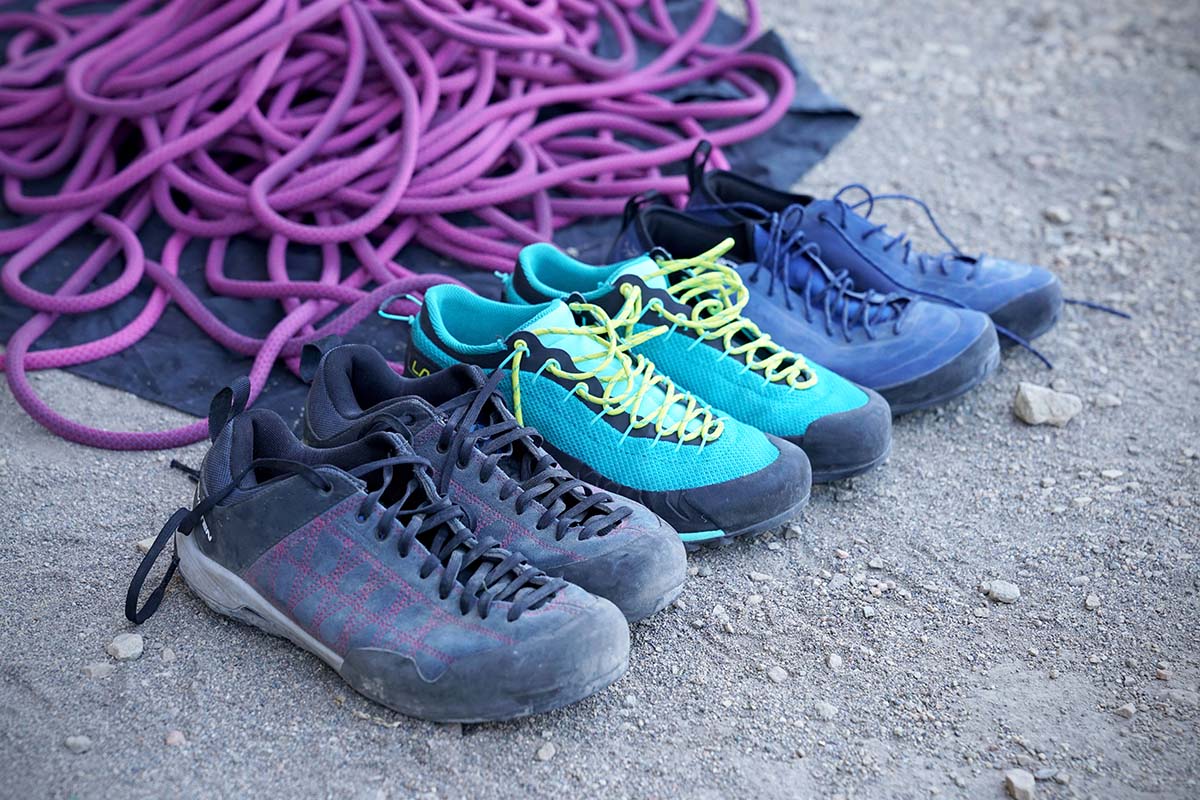
All-Around
All-around approach shoes are your standard designs, built to tackle the mix of trail and rock that stands between you and your climbing objective. These designs are comfortable and supportive for long days of hiking, offer traction on both rock and wet terrain, and are roomy enough to accommodate foot swelling. While many shoes in this category can hold their own on technical rock (for these features, see our “Scrambling” category below), their design prioritizes performance on the approach—this is most epitomized in the sole, which often features a versatile combination of a climbing zone, smooth lugs, and aggressive heel. All-around shoes come in both leather and synthetic (often knit or mesh) uppers, so you can decide whether you want to prioritize durability or breathability. And finally, if you’ll be hauling your shoes up a multi-pitch climb for the descent, it’s worth considering this category’s more lightweight options. A couple of our favorite all-around shoes include the La Sportiva TX4 Evo and Scarpa Crux.
.jpg)
Scrambling
Some climbers favor an approach shoe over a climbing shoe for easy-to-moderate climbing like scrambling in the Flatirons, guiding clients up mid-fifth-class routes, or moderate ridgelines in the alpine. More comfortable than a climbing shoe but more precise than a standard approach shoe, designs in our scrambling category place a priority on technical-rock performance with low-profile builds, flat and stiff soles with dotted rubber (often forgoing a heel brake), and a precise toe edge that provides a delicate connection with the rock. Because they carry many of the features of a climbing slipper, scrambling shoes lack support, comfort, and traction for long sections of trail, and aren’t our first choice for those looking for a one-quiver option. Popular approach shoes in this category are the La Sportiva TX Guide and Scarpa Gecko.
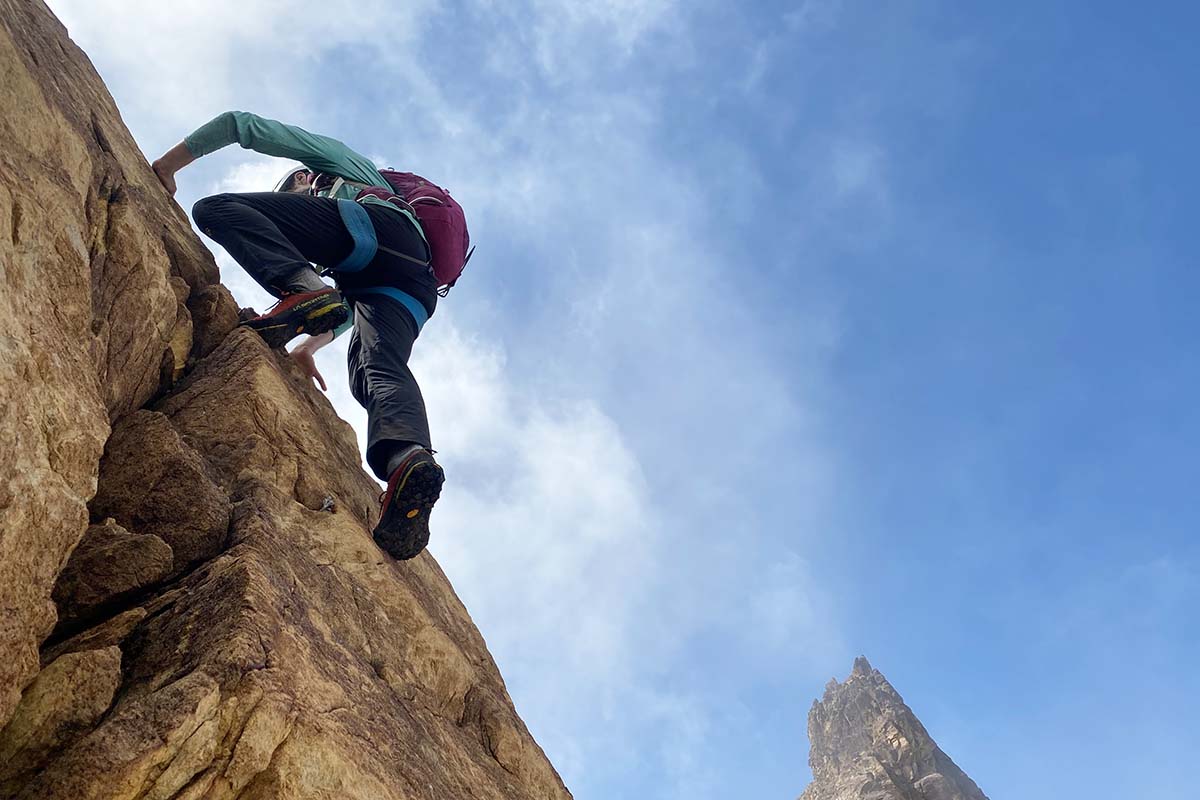
Cragging
For most climbers, heading to the crag or boulders means a short walk on a trail followed by a day of climbing in one location. The sticky rubber sole and stiff build of an approach shoe might come in handy for rock hopping, but once you’re at your destination you’ll want a comfortable shoe that’s easy to get on and off (we’ll often bring a pair of flip flops to the crag for this very reason). As such, approach shoes in our cragging category (also ideal for bouldering) are on the more casual side, with features like a knit upper, a microfiber liner for comfort against bare feet, and a heel that folds down for a quick slipper. Cragging shoes can also be a good fit for multi-pitch climbs when you want a lightweight shoe to haul up the climb for use on the descent. The Black Diamond Session Suede and La Sportiva TX2 Evo are two of our favorite cragging-specific approach shoes.
Mountain
If you’re headed to an alpine climbing area such as the Bugaboos or the North Cascades, you’ll want an approach shoe that can handle snow and technical cross-country terrain. Many of the shoes in our all-around category can get the job done, but dedicated designs will provide better stability and protection with beefier leather uppers, sharper tread and deeper lugs, mid-height builds, and built-in waterproofing. Further, those using strap-on crampons will want a relatively stiff sole and upper (leather is better than mesh), and a raised collar will provide more comfort and security. Approach shoes in our mountain category include the Salewa Mountain Trainer 2 GTX, Zamberlan Salathe GTX RR, and La Sportiva Aequilibrium Speed GTX.
.jpg)
The sole of an approach shoe can tell you a lot about what it’s designed for. There are three main areas to an approach shoe sole: the toe box, the midfoot, and the heel brake area. Starting with the toe box, most approach shoes have a large rubber rand that surrounds the front, sides, and top of the toes, mimicking a climbing shoe. And approach shoes that are made to edge and smear well will have a smooth patch on the sole underneath the toe, allowing for close and responsive contact with the rock.
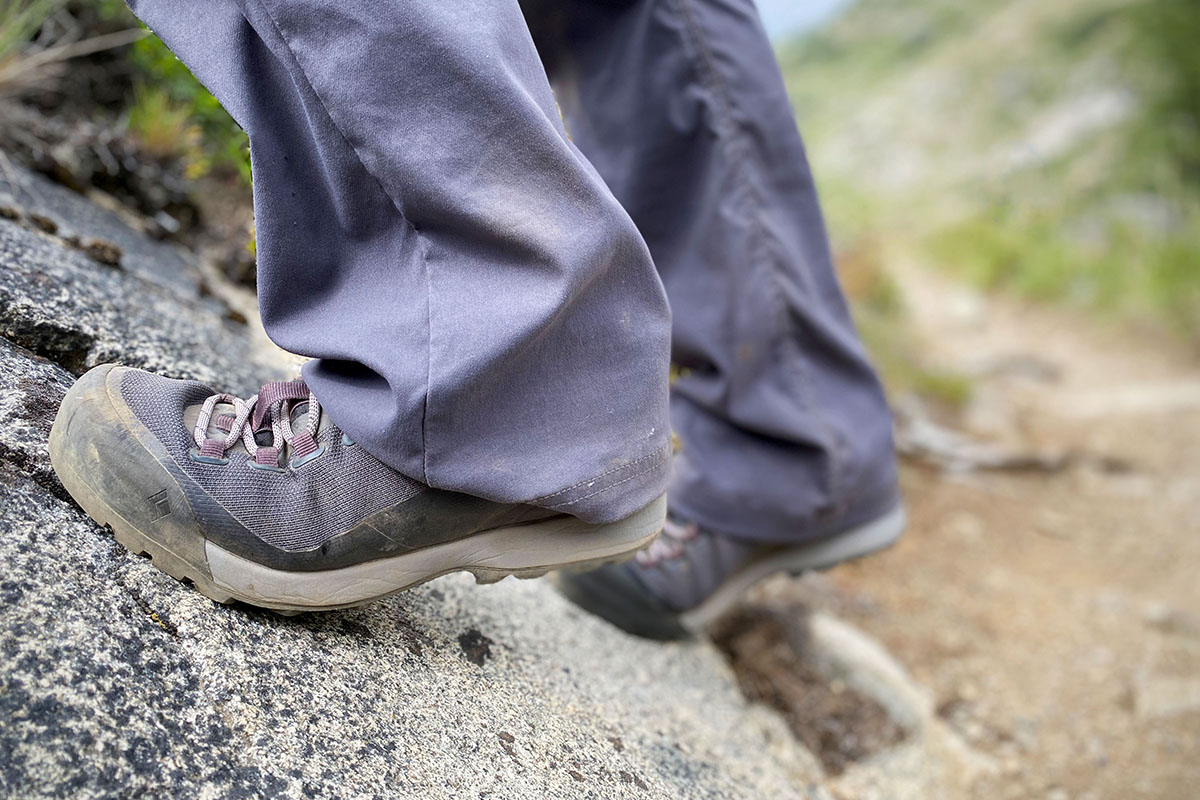
Moving to the midfoot and heel brake, the outsole design here can vary quite a bit between models. Generally, the dotty style found on shoes such as the La Sportiva Boulder X provides great surface area on rock but fails to perform on wet or snowy terrain. On the other hand, models with sharper tread, like the Salewa Mountain Trainer 2, are made to provide a high amount of traction on wet and snowy terrain but are generally more clunky on technical rock. Lastly, most approach shoes will have a heel brake, made of thin strips of sticky rubber for traction and downhill braking. Some shoes lack a heel brake, some lack a technical patch on the toe, and all will have slight variations in the midfoot rubber. Pay attention to each of these features to make sure you purchase an approach shoe that meets your specific needs.
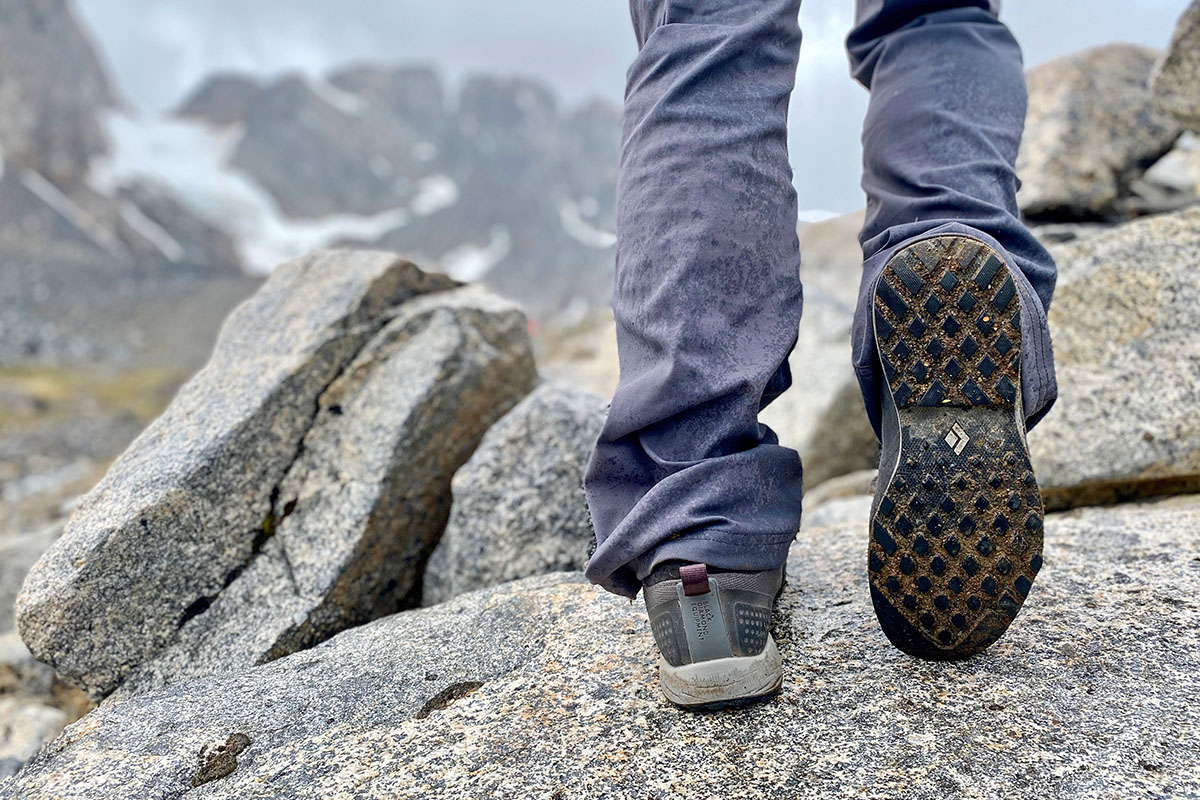
For the majority of users who wear their approach shoes exclusively for hiking and moderate scrambling, edging is a non-issue. But for those who are proficient enough to climb technical terrain in the same shoes they hike in, a stable edging platform is essential. Most shoes in this category have a flat rubber patch under the big toe, providing a smooth and responsive platform for edging. Not only that, but climbers will want to look for models where the rubber rand comes flush to the sole (as seen in the Scarpa Gecko). This provides a seamless, stiff edge like that of a climbing shoe. Even to the uninformed eye, this edge will look different from one that is made up of layers of cushioning, like that of La Sportiva’s Boulder X or Scarpa's Crux.
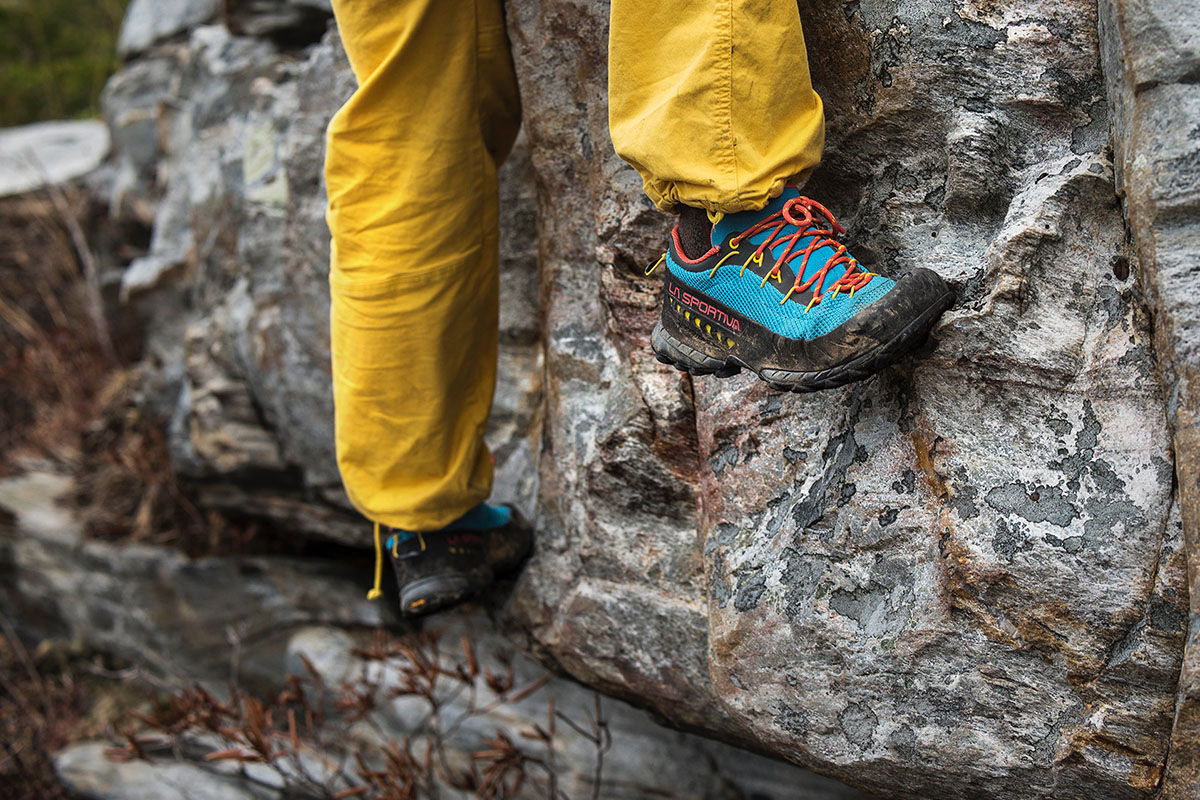
With a few exceptions, climbers generally limit their endeavors to days when conditions are dry and warm. In the world of approach shoes, breathability is a far more important factor than waterproofing. However, waterproofing is a nice security blanket if your climbing takes you into the mountains. The extra protection that comes with a waterproof and breathable membrane inserted into the shoe is great for creek crossings, surprise rainfall, or crossing snow. However, the extra layer adds weight and impacts breathability pretty significantly, hence why there are very few Gore-Tex models on our list. If you know you’re looking for a waterproof approach shoe, however, we’ve found Gore-Tex models to work consistently well, including the Zamberlan Salathe GTX RR and Salewa Mountain Trainer 2 GTX.
Recently, we’ve seen an increase in the use of synthetic materials for approach shoe uppers, with models like the La Sportiva TX2 Evo. Although you get very little water resistance from these shoes, it’s important to remember that their mesh and/or knit uppers wick water far better than leather and do not grow heavy when wet. As a result, they also dry out more quickly after a full dousing. For this reason, we think synthetic materials are a great option for summer travel when wet feet aren’t a threat to your safety. That said, we still opt for leather shoes (like the TX4) for most approaches in the mountains.
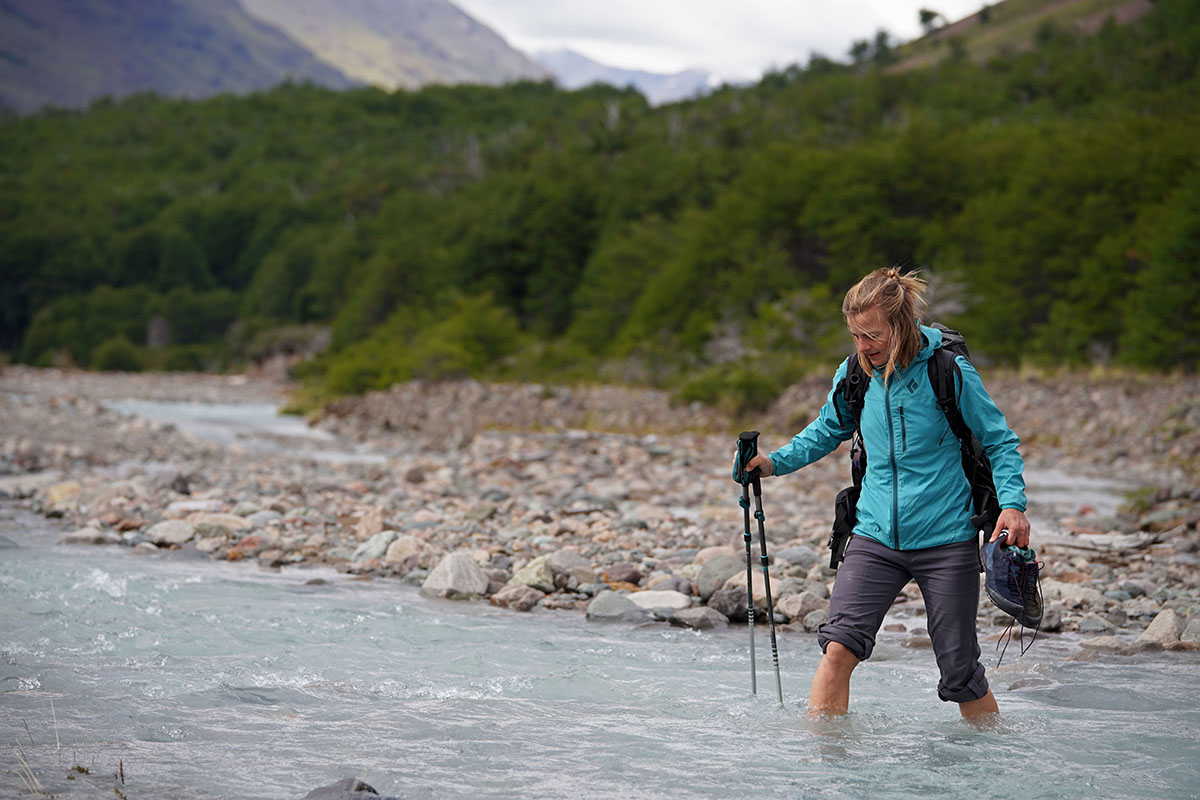
In terms of breathability, approach shoes constructed with a mesh or knit upper are going to breathe better than suede or leather versions—and far better than Gore-Tex-equipped models. But there's certainly a trade-off: Highly breathable shoes (like the La Sportiva TX2 Evo) are not as durable or protective as their leather counterparts (the La Sportiva Boulder X, for example).

Additionally, shoes with a mesh upper are far more permeable to small particles such as sand, dirt, and snow (although this will largely depend on the specific weave). Additional features such as a sock-like liner—or even a short gaiter—can aid in keeping trail debris at bay. Long story short: Mesh shoes are your best bet for warm-weather approaches, but you can expect some noteworthy compromises. If you’re looking for the best in protectiveness and durability, we’d recommend a shoe with a leather or suede upper instead.
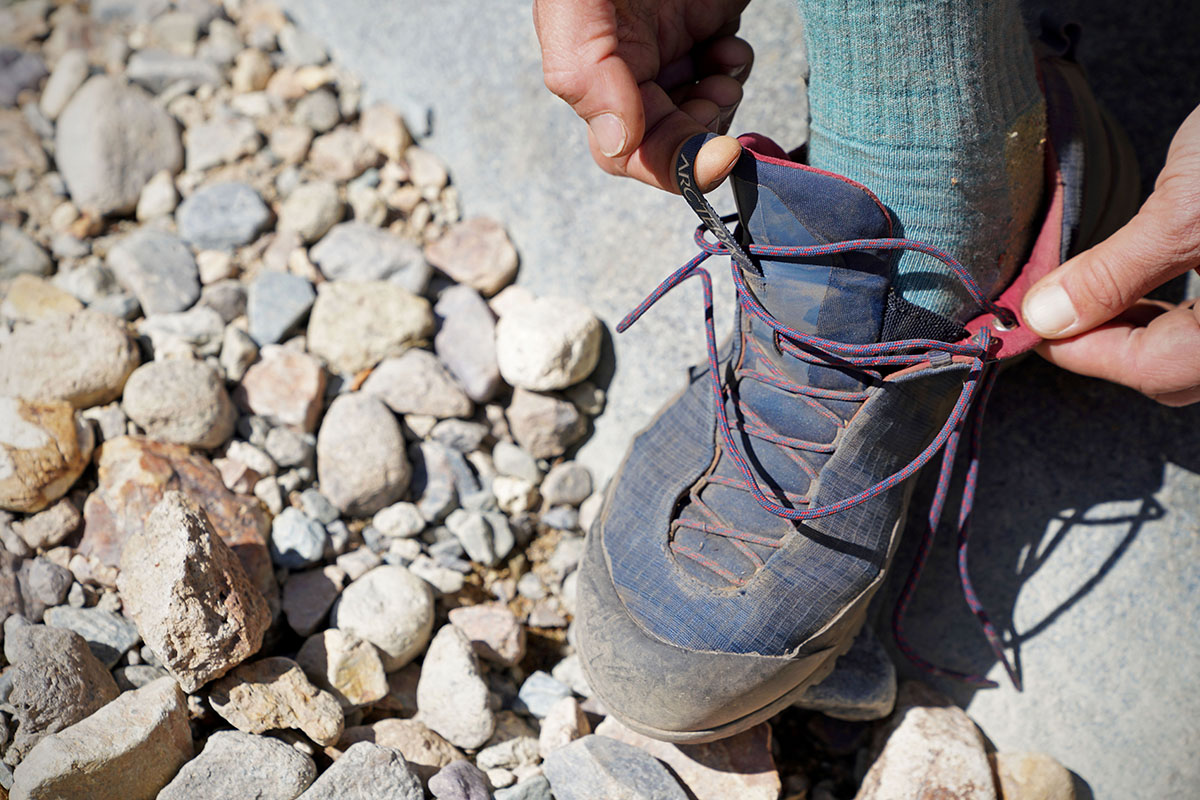
The weight of an approach shoe matters both when it’s on your foot and when it’s in your climbing pack or dangling from your harness. Hiking mile after mile with less than a pound on each foot is going to feel far less strenuous than it would with a multi-pound pair of boots, and the same goes for carrying the shoes. The ideal weight of your approach shoe depends on several factors, including the difficulty of the terrain, how long you plan to hike in your shoes, and if you will leave your shoes at the base of the climb or carry them up with you. Heavier shoes are generally more durable but typically don't allow for as much precision or breathability as lightweight models.

If you plan to carry your shoes just as often as you wear them, it could be worth opting for a lightweight design like the La Sportiva TX2 Evo (1 lb. 4.4 oz.). However, there are always trade-offs to shaving weight. With the TX2 Evo, you can expect less protection, stability, and durability than beefier models like the TX4 Evo (1 lb. 12 oz.). In other words, if your approaches generally require a high level of performance from your shoes, be careful not to streamline too much.
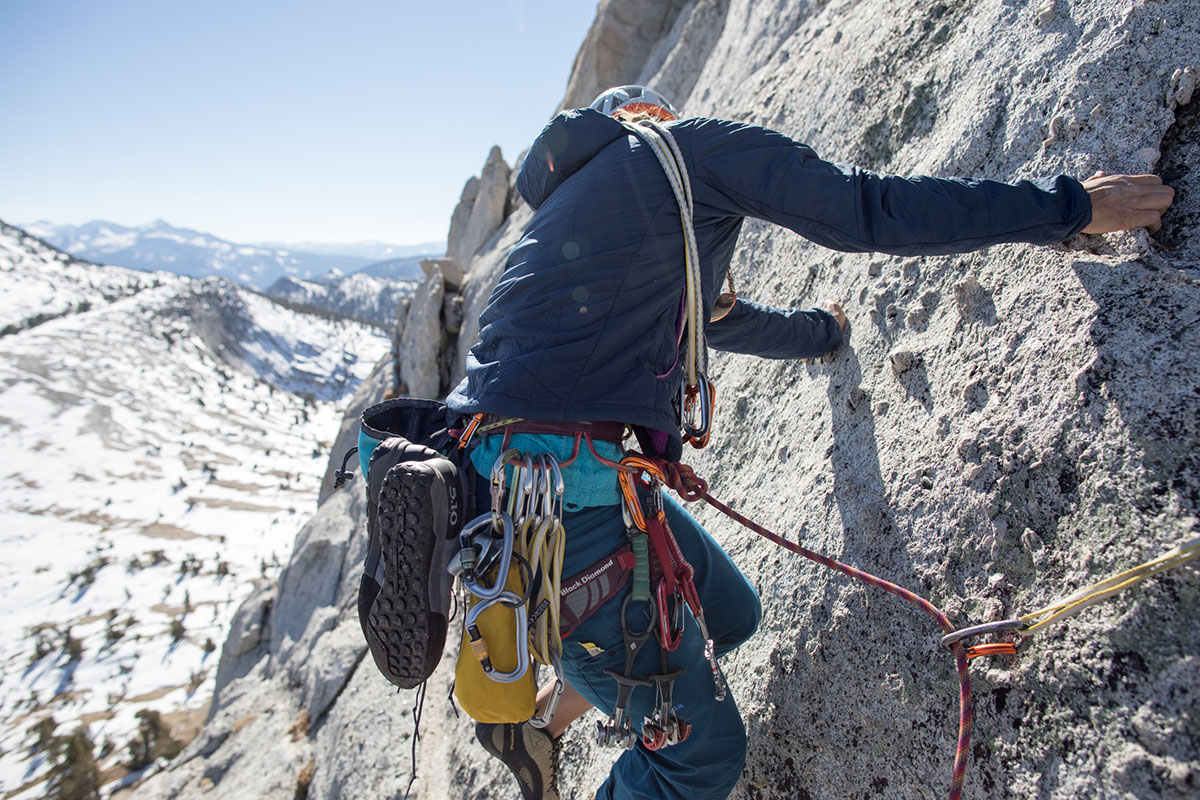
There always is a compromise when choosing the size of your approach shoe. Many designs in our scrambling category are made to fit snugly so that they are responsive and stable on technical rock. Shoes in our all-around and mountain categories should fit more like a hiking shoe, with a bit of room for the toes to move around for downhill slogs and over long distances as the feet swell.
Most approach shoes are constructed with a to-the-toe lacing system, so it is possible to provide your toes with more or less room depending on the activity. Because of this, we recommend sizing your shoe comfortably with the ability to cinch the laces down tightly. Additionally, make sure you buy a model that fits the width of your foot well. Different brands or models fit differently. For example, La Sportiva's Boulder X is known to be rather wide, whereas their TX Guide has a narrow fit.
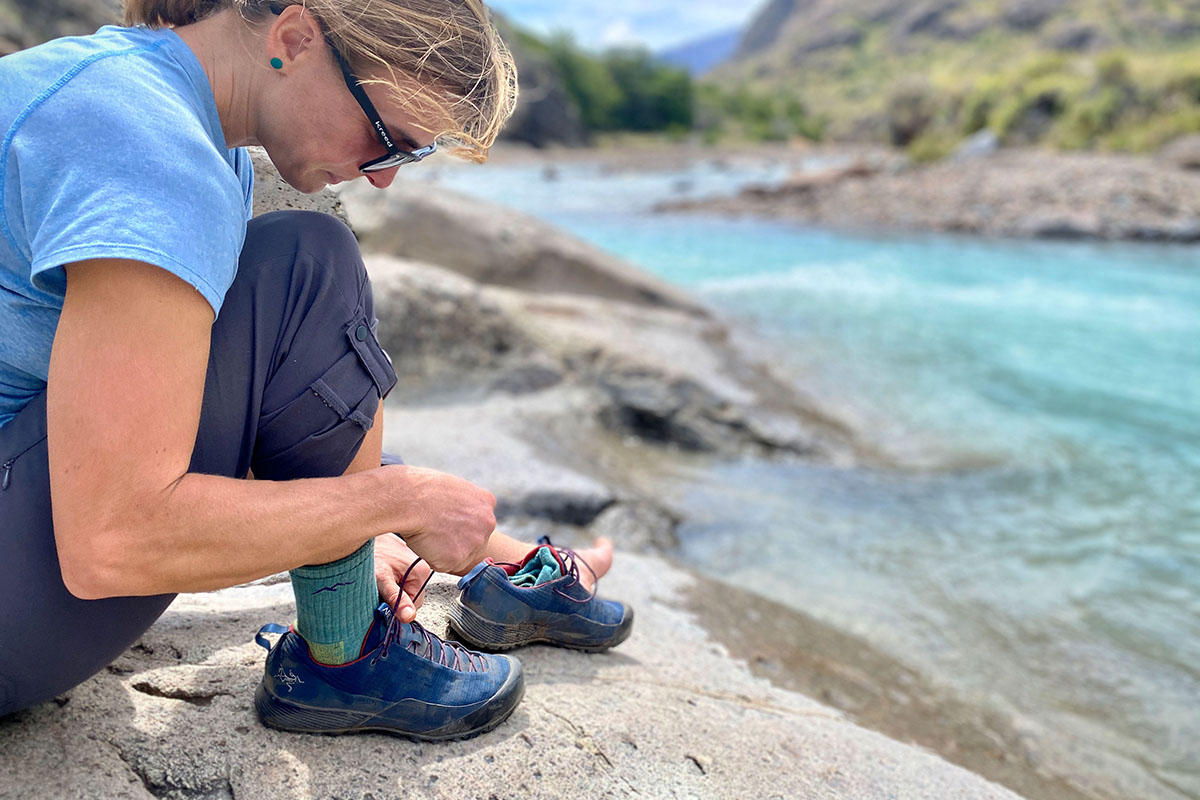
Most approach shoes have built-in shanks or internal supports to provide a degree of stiffness. This construction differentiates these shoes from light trail runners, though they are a far cry from the full shank of a mountaineering boot. In general, the more technical the terrain—such as snow, scree, or steep trail—the more you will benefit from a stiffer approach shoe (examples include shoes in our mountain category like the Salewa Mountain Trainer 2 GTX). A stiff shoe will be less comfortable on easy trail and during high mileage days (it’s for this reason that we hesitate to recommend approach shoes to hikers), but on uneven terrain it will keep your foot from flexing and straining to support itself.
Additionally, the stiffer an approach shoe is, the better it will perform on technical rock (within reason, of course). To illustrate this point, imagine edging on a small hold while wearing a pair of running shoes. In our mind’s eye, the soft cushioning compresses, the shoe doesn’t hold its form, and your foot scrapes off the hold. Now, perch on that same edge with a stiffer, more precise approach shoe. The rubber doesn’t compress much and the sole maintains a solid platform. For this reason, many of the shoes in our scrambling category (the La Sportiva TX4 Evo and Scarpa Gecko, to name a couple) have rigid midsoles and soles. Again, you’ll have to find the right balance for your needs as stiff shoes can feel clunky and onerous on the trail for many.

The majority of shoes on our list have a rand that extends over the toe box, providing protection from stubbed toes and additional traction on rock. Many of these shoes have full, wraparound rands, extending this level of protection and traction around the entire foot. The larger the rand—both in height and in area covered around the foot—the more durable the shoe and the better it will perform in cracks and on rocky trails.
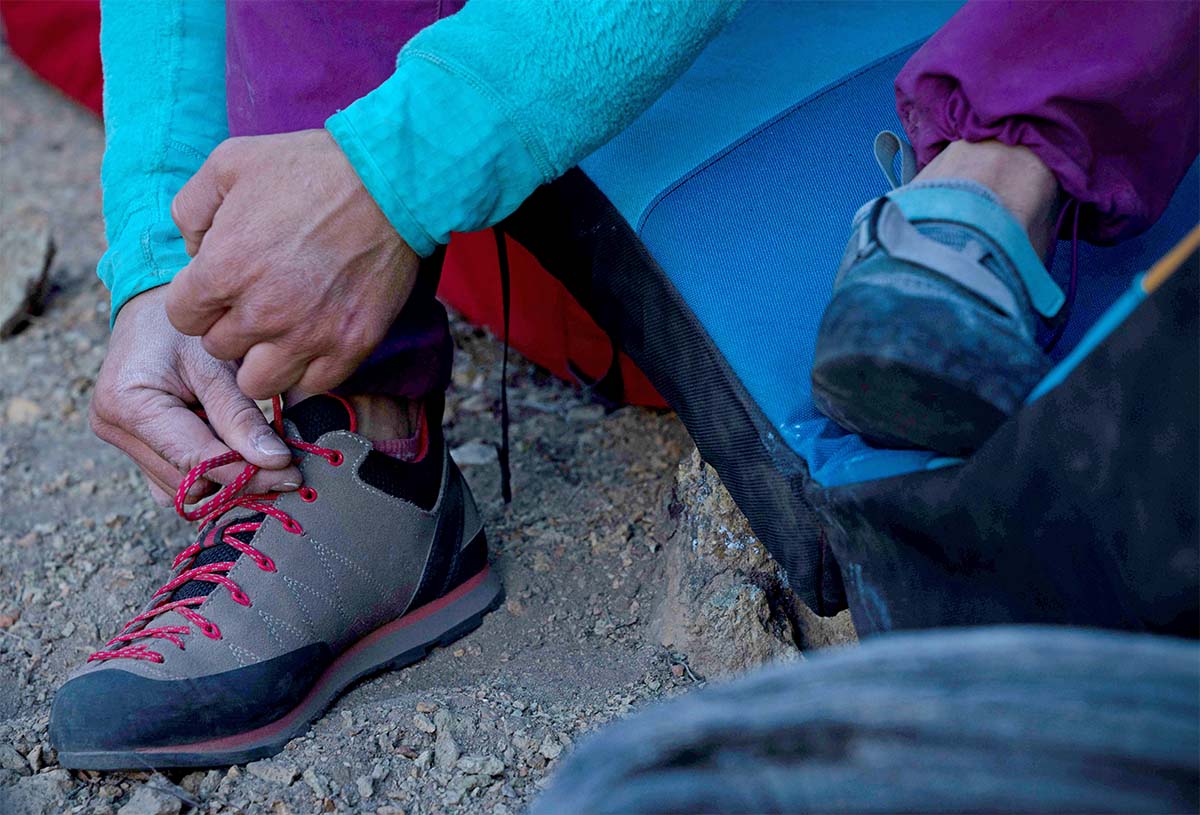
The type of material used in a shoe’s upper—the fabric that connects to the rubber outsole—correlates directly with its durability, water resistance, and breathability. Most often, a shoe will be made with synthetic mesh or knit material, leather, or a mix. Below we spell out the pros and cons for the most common materials used in approach shoes.
Synthetic
Mesh-woven nylon, open mesh panels, and knit uppers are becoming increasingly common in approach shoe construction as manufacturers seek to shave weight from their models. As we covered above, these airy synthetic uppers certainly aid in breathability and cutting weight but detract from the waterproofing, durability, protection, and climbability of the shoe. In the end, we love mesh or knit shoes during the summer months, but they’re not ideal for wet or snowy terrain or particularly technical climbing.
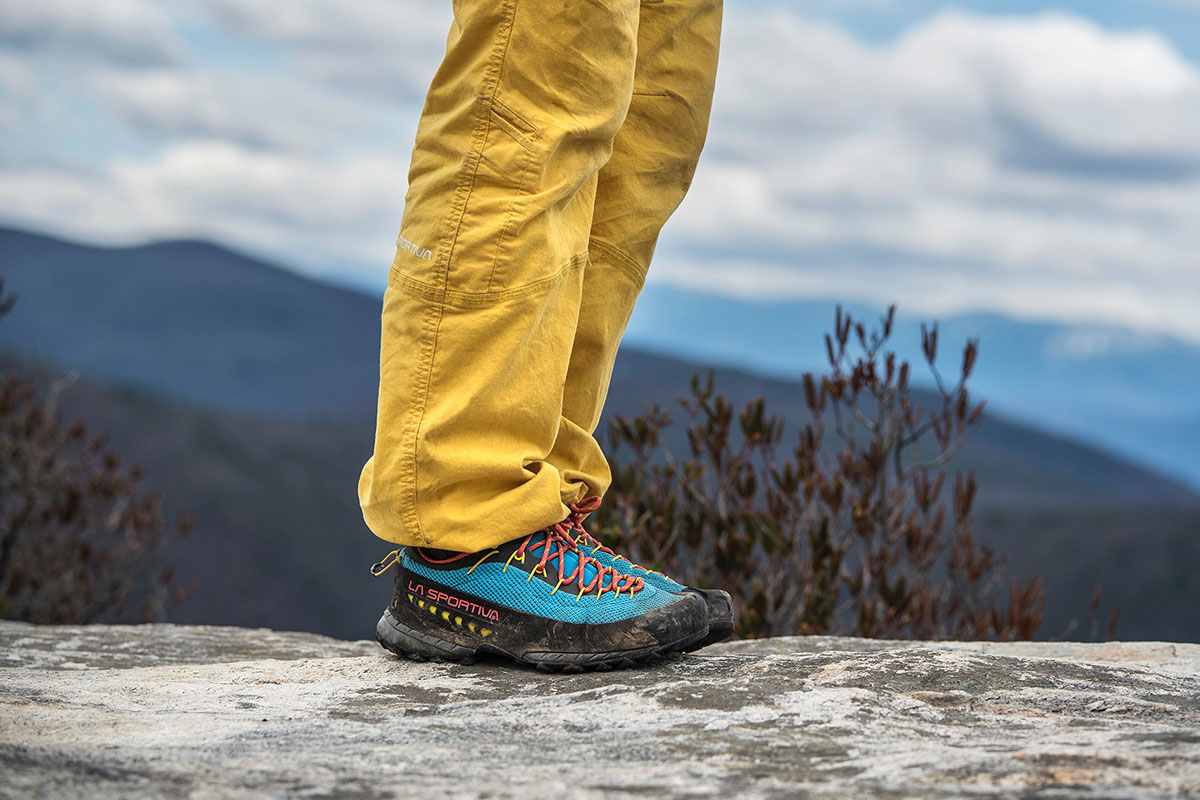
However, as we’ve mentioned a few times throughout this article, there are some synthetic uppers that manage to achieve many of the benefits of leather while maintaining a high degree of breathability. Particularly, Scarpa's mesh-like synthetic seen on their Mescalito Planet above is impressively durable and protective—so much so that we’ve come to think of this shoe as being in the same class as leather designs like the La Sportiva TX4 Evo and Scarpa Crux. It also comes with the added benefit of being able to wick water and dry out quickly, whereas leather can grow heavy when wet.
Leather
The majority of approach shoes, similar to climbing shoes, are made with a leather upper. Without getting too deep into technicalities, suede, leather, and Nubuck are all derived from the same material and generally perform similarly. On approach shoes, this leather will be lighter and more flexible than the typical glossy full leather you might see on an old hiking boot. Of all upper materials, leather will provide the most protection, durability, and water resistance. However, it’s the least breathable. Occasionally, as in the case of the Scarpa Gecko, leather and mesh will coexist to provide both breathability and durability.
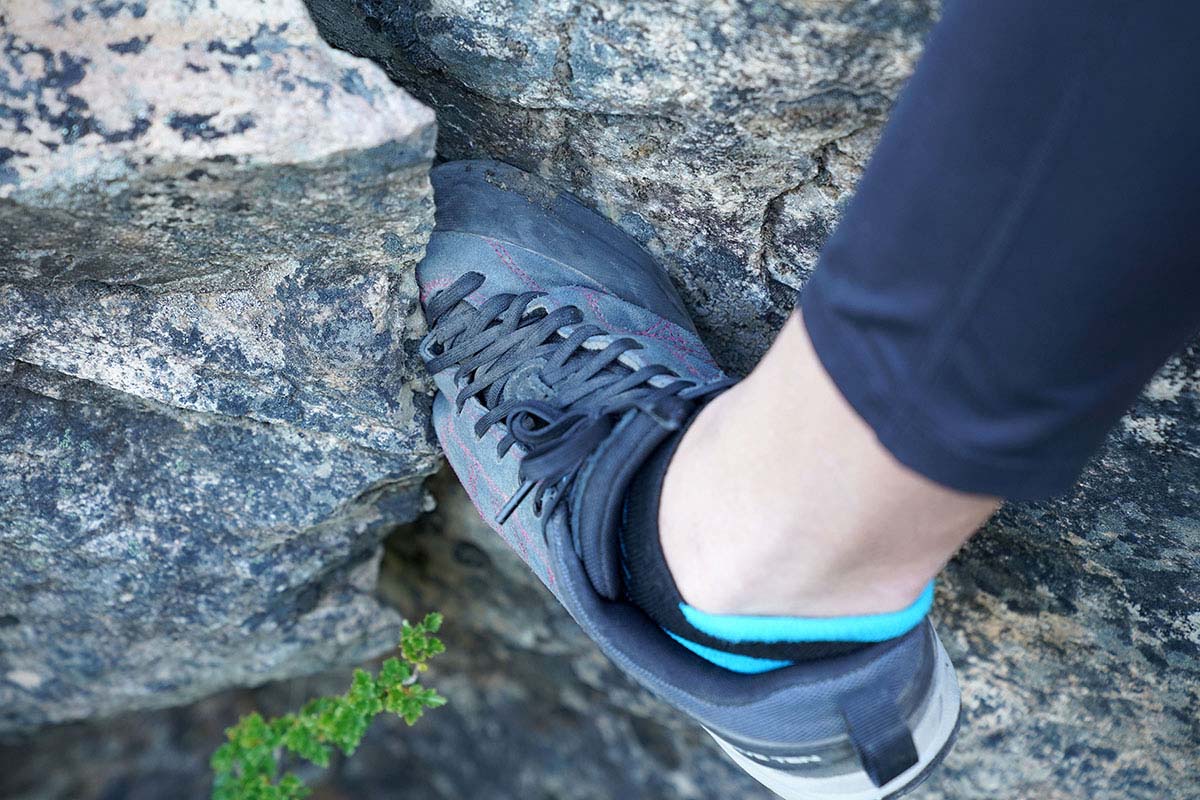
Leather also tends to stretch. Because approach shoes aren’t sized as tightly as climbing shoes, approach shoes will not stretch as noticeably. However, especially when wet, full leather models such as the La Sportiva Boulder X certainly will expand, leading to a less supportive fit. On the flip side, as these all-leather models dry, they will conform more to the size of your foot (if they dry while on your foot) and fit even better.
.jpg)
Part of the beauty of approach shoes is their ability to pull climbing moves on low-fifth-class terrain without the discomfort that comes with traditional tight climbing shoes. Approach shoes can feel nearly as cozy as hiking or trail running shoes, but we will often wear them to climb 5.7 or 5.8 pitches on long traverses or big-wall missions. Demanding mountain objectives like these often require you to frequently swap between approach and rock shoes, so it's helpful to find a lightweight pair that easily slips on and off and won't weigh your harness or climbing backpack down. You will often be fighting a tight weather or time window on these climbs, so quick, efficient transitions are key. Light, streamlined shoes are the ticket here.

The slick La Sportiva TX2 Evo or TX Guide (better for technical climbing) are two of our favorite models for these objectives. Clunkier, more durable boots like Zamberlan's Salathe GTX RR are great for all-day use over harsh terrain but are too heavy and take too long to slide on and off during fast-and-light missions. Big-wall climbs may merit a slightly heavier and stiffer approach shoe than long traverse climbs or scrambles since you'll often spend hours stepping high in aid ladders, and a thin, flexible approach shoe can squeeze your foot uncomfortably over time. We write from experience. The top-rated La Sportiva TX4 Evo is our favorite approach shoe for big-wall climbs like multi-day ascents of El Capitan in Yosemite National Park.

Our impact on the environment has never been of greater concern, and we’re happy to see many outdoor brands rising to the challenge by incorporating eco-friendlier materials into production. Two of the most common measures to look out for are the use of recycled materials and resoleable platforms that can be replaced to maximize the shoes’ lifespan. For reference, La Sportiva’s TX4 and TX2 Evo both utilize recycled components throughout, with tread and foam that can be replaced once worn down (you will need to send the shoes into a La Sportiva-approved cobbler). Overall, we appreciate when brands go the extra mile in improving their lineup and look forward to seeing more sustainably built shoes hit the market.
.jpg)
Approach shoes aren’t cheap, and much can be done after purchase to ensure their longevity and performance. Below, we offer three suggestions for shoe care.
Keep Them Clean
Your shoes are getting you through some tough environments, and mud, bits of sand or dirt, and wet terrain can all add up. At the end of a day out, feel free to give the shoes a spray down with the hose if need be, leaving them out to dry completely. Turn your shoes on their sides and stuff them with newspaper to speed up drying. Additionally, throughout the day or at the day’s end, take out the insole and give your shoes a good shake—all that sand and dirt can accumulate and abrade the material quickly if not taken care of.
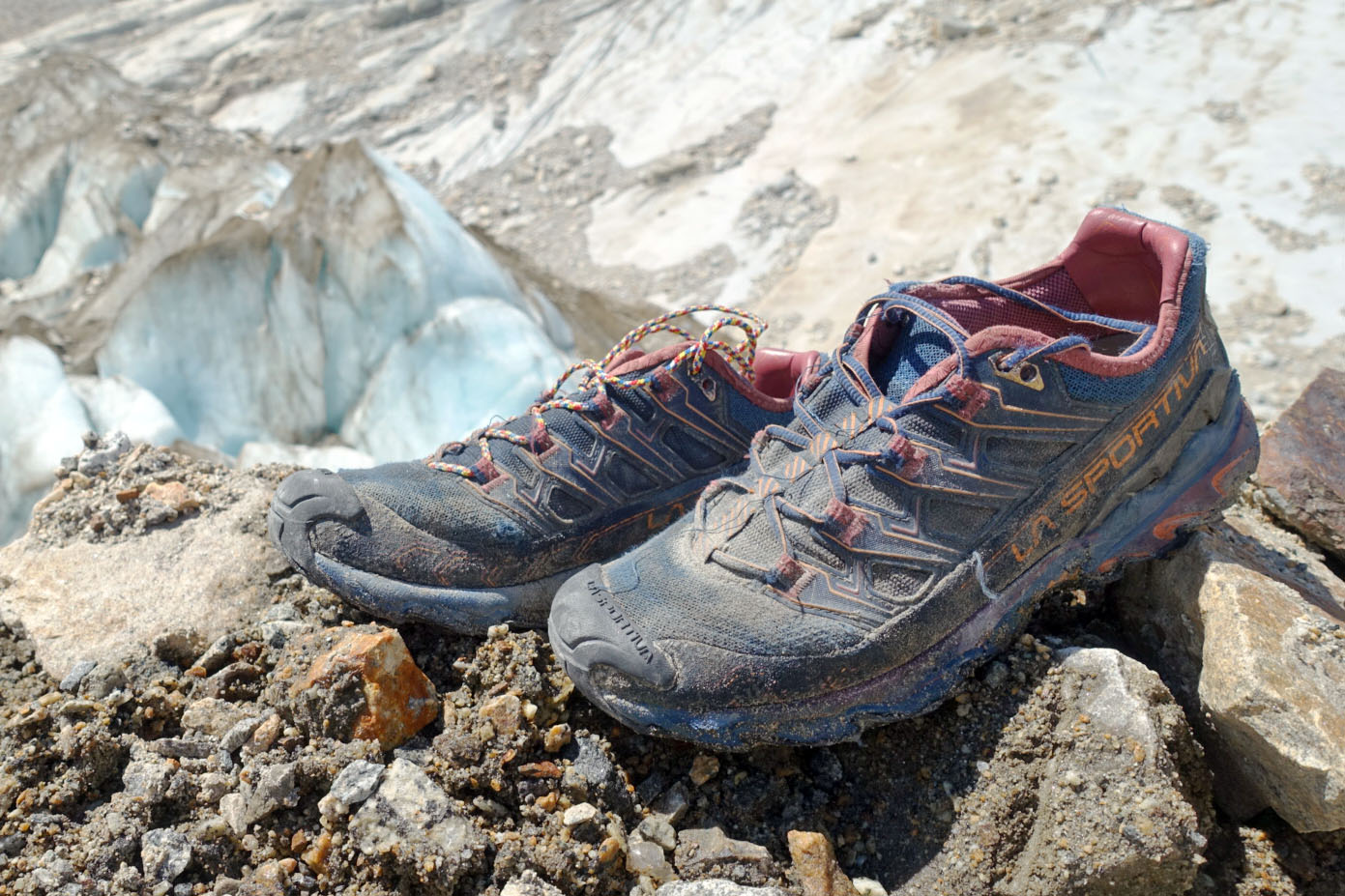
Conditioning/Waterproofing
If you have approach shoes with a leather upper, it is wise to treat them with a leather conditioning/waterproofing product. If not treated, leather can absorb water, making it heavy and more prone to stretch and shrink. Nikwax and Gear Aid both have a full lineup of products that will do the trick.

Seam Gripping the Seams
Climbers often apply seam grip to the seams of their climbing shoes (over the stitching and where the rand meets the leather) to reinforce them against abrasion from cracks. This simple practice drastically increases the lifespan of a pair of climbing shoes. You can perform the same practice with approach shoes, especially if you’re planning on using the shoes for scrambling or technical climbing. Additionally, when aid climbing, expect your shoe’s toes to blow out extremely quickly if not reinforced. Gear Aid products such as Seam Grip or Aquaseal can be applied to these wear-and-tear areas upon purchase and many times thereafter.
Approach shoes are specifically designed for climbers as a replacement for hiking boots, so what’s with the mid-height approach shoe? Climbers may opt for a mid-height model for a variety of reasons. Perhaps you need more ankle stability or protection, whether you’re carrying heavy loads over tricky terrain or preventing ankle rolls. Perhaps you want a lightweight hiking boot but crave the sticky rubber of an approach shoe. Perhaps you plan on traveling over snow a great deal and want more coverage along with a sturdy attachment for a pair of crampons. Or perhaps you’re a big-wall climber who needs more support when standing in aiders for days on end.
.jpg)
The mid-height approach shoe can be used to level up—both weight-wise and stability-wise—from a typical approach shoe or level down from a hiking boot. When the hiking is technical and weight is less of an issue (i.e., you’re not planning on carrying your boots on a climb), the mid-height shoe is an excellent choice. Approach shoes in this category include La Sportiva's TX4 Evo Mid GTX (not featured above), as well as the La Sportiva Aequilibrium Speed GTX (which, granted, is more of a mountaineering boot than an approach shoe).
Back to Our Top Approach Shoe Picks Back to Our Approach Shoe Comparison Table